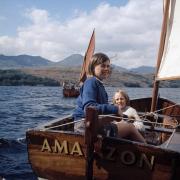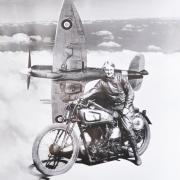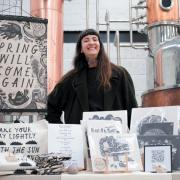Stuart Wallis's love of motor cars went one step further when his intention to create a float for Ringwood Carnival turned in to constructing a carbon copy of the famous Chitty Chitty Bang Bang...
Stuart Wallis’s love of motor cars went one step further when his intention to create a float for Ringwood Carnival turned in to constructing a carbon copy of the famous Chitty Chitty Bang Bang. Carole Varley took to the road to discover how it all came together
Some children seem to have all the luck. As not only can the father of Lily Wallis, 11, her brother Tom, nine, and sister Zoe, seven, breathe fire at bonfire parties, but when they ask him to make them a Chitty Chitty Bang Bang Car, as in the film, “like a doting dad, I do it in my spare time,” says 52-year-old Stuart Wallis. As for the fire breathing, Stuart explains that this is just a sideline he picked up as a teenager.Actually, the idea of the car first came from Lily’s friend and neighbour Chloe, whose ambition it was to be a childcatcher, one of the less savoury characters in the 1968 film of Chitty, Chitty Bang Bang, which stars Dick Van Dyke as Caractus Potts, an eccentric professor who makes wacky machinery, of which the car is his most spectacular example.
The transformation beginsSo Stuart, who also runs New Forest Metalwork at Ringwood, where his six-strong team make bespoke stainless steel balconies and wrought iron gates and railings, forked out �1,000 for a clapped-out 1976 Land Rover. He stripped it down to its bones, elongated the chassis, and then gradually built it back up again, using stills from the film pinned up on the wall as his pattern, the measurements taken from another replica of the car at the National Motor Museum at Beaulieu, and half a boat. The work started in May and had to be finished by September, in time for the Ringwood Carnival parade, which the family was hoping to enter and make Chloe’s dream come true, and also raise some money for the Cicely Foundation, which supports children’s charities, a cause dear to Stuart’s heart.
Going bananasUnlike Caractus Potts, though, 52-year-old Stuart did have some idea of what he was letting himself in for. As he says, “I don’t think you would go in for a project like this if you didn’t know that you could do it.” And he does have some form, having already transformed a VW Beetle into Herbie, the anthropomorphic character that has featured in several Disney films. “I was brought up on cars. I have always been tinkering and modifying them, and am pretty fluent with engines,” he explains.He was also lucky enough to be able to call on the services of his employees, in particular Pawel Kinast, who hails from Poland. As a fully-trained car mechanic, as well as a metalworker, Pawel was only too happy to put in some of the thousands of hours that were needed to transform the car, work which became invaluable when Stuart was put out of action for a few weeks, having fallen off a roof and badly smashed his foot.
A family affairStuart himself trained as a heavy-duty engineer, his apprenticeship served making the Thames Flood Barrier, after which he satisfied his wanderlust by working on oil rigs and spending a couple of years travelling the world with his wife Louise, before the couple settled down to have children. “I wanted an easier life,” says Stuart, “and starting the business meant I could also spend more time at home with the children.”As it turned out, the Chitty Chitty Bang Bang project became very much a family affair and the children pitched in to help Stuart and his team build the car, with Lily and Tom even doing a spot of welding, as well as helping to make all the costumes, again copying them straight from the film.
Street legal On the day I visit, the car sits gleaming in the workshop and Stuart proudly displays its array of gadgets, like the eight sets of air horns, which can reproduce the sound of everything from a police siren to farmyard animals, the amplifier under the bonnet, which has 1,000 watt loudspeakers that blast out music from the film, and the smoke machine. He also spreads the car’s red and yellow wings at its sides and, although the vehicle can’t actually fly, it is totally roadworthy and completely street legal. “Oh yes, I’ve picked the kids up from school in it, and we have driven about the countryside. The whole shebang works,” says Stuart.So what did the children make of it all? “When we finished it, I don’t think they could quite believe it,” he says. “Even I didn’t think it would come out so good as it has. After all, it was just going to be a float to start with. But it has all been good fun for them.”
Prize winning As a float in the carnival, it won first prize, and collections made from carnival-goers raised almost �2,000, which was match-funded by the Cicely House Foundation to go towards Julia’s House Children’s Hospice. It also brought the family a measure of fame, as not only were the local and national press, and magazines like Top Gear, intrigued by the story, but the car also made the headlines in countries as far away as India and Pakistan. “I’ve been really surprised at the response we’ve had everywhere,” says Stuart.So now that they’ve all had their fun, the car is up for sale and, although the children are sad to see it go, Stuart is hoping to raise enough to cover his costs, plus a little extra to go towards less advantaged children through the Cicely House Foundation. But who does he think will buy such a vehicle? “Oh, I’m sure there’s a rich dad somewhere,” he chuckles.So, what’s next then, a Harry Potter flying Ford Anglia? “No, my next project is to build a house,” says Stuart, smiling at his wife as she hoves into view with some tea. Let’s just hope the children don’t get to him first.
Can you help?
The Cicely House FoundationThe Cicely Foundation at Christchurch works to help deprived, vulnerable and needy children, both at home and abroad, to overcome some of their difficulties. The main focus of the foundation involves supporting work linked to education health and wellbeing. Julia’s HouseThis children’s hospice at Corfe Mullen, Dorset, provides respite care supporting children in their own homes as well as at Julia’s House itself, with the aim of enhancing the quality of a child’s life and providing a happy, homely environment. In 2008 the Cicely Foundation donated �3,000 towards the work of the hospice, and last year paid for a number of respite trips for parents and children at Hay Outdoor Training Centre in Wales. They are now funding the �6,000 salaries of two part-time siblings workers.For more information, visit: http://www.cicelyfoundation.com/ To make a donation, visit www.justgiving.com/Stuart-Wallis


























